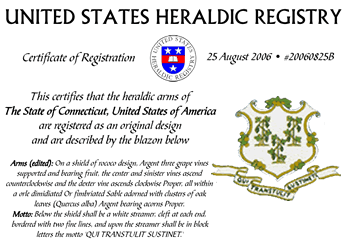U.S. Heraldic Registry
Registration of contemporary and historical American heraldry
The State of Connecticut, United States of America
Registration number 20060825B
This certifies that the heraldic arms of The State of Connecticut, United States of America are registered as an original design and are described by the blazon below

Sources
The historical note is quoted from FOTW Flags Of The World website at URL http://flagspot.net/flags/. Original author is Joe McMillan.
Image from FCIC website at URL http://www.pueblo.gsa.gov/
Historical note
The Connecticut coat of arms is defined by § 3-105 of Connecticut General Statutes as follows: "A shield of rococo design of white field, having in the center three grape vines, supported and bearing fruit. The vine located in the center of the shield and the vine located on the right side of the shield shall ascend in a counterclockwise manner. The vine located on the left side of the shield shall ascend in a clockwise manner. The bordure to the shield shall consist of two bands bordered by fine lines adorned with clusters of white oak leaves (Quercus alba) bearing acorns. Below the shield shall be a white streamer, cleft at each end, bordered with two fine lines, and upon the streamer shall be in block letters the motto 'QUI TRANSTULIT SUSTINET.'"
The seal of the old Saybrook Colony in what is now Connecticut, introduced in 1639, depicted 15 grapevines, with a hand issuing from clouds in the upper left corner holding a scroll inscribed "Sustinet qui transtulit (He who transplanted sustains)." This seal was transferred to the Connecticut Colony when it purchased the land and fort of the Saybrook settlement in 1644 and used de facto by the colony's General Court (legislature). On October 9, 1662, coincident with the promulgation of Connecticut's royal charter, the seal was formally adopted by the general assembly as the seal of the colony. It was used until 1687, when James II's despotic royal governor Edmund Andros abolished self-government throughout New England; the original seal disappeared during this period. The charter of Connecticut was restored in 1689. On October 25, 1711, the governor and council (upper house of the General Assembly) directed the purchase of a new seal, which was essentially that in use today. The grapevines were reduced to three--perhaps to represent the three original colonies of New Haven, Saybrook, and Connecticut (Hartford). The motto scroll was moved to the bottom of the oval seal and the words rearranged to read "Qui transtulit sustinet." The only change to the seal of Connecticut since then was made in May 1784, after independence, changing inscription on the rim from SIGILLUM COLONIAE CONNECTICUTENSIS to SIGILLUM REIPUBLICAE CONNECTICUTENSIS (Seal of the State of Connecticut).
From an early period, the three grapevines were used on a shield as the arms of Connecticut, appearing in that form on state military colors among other places. The current official depiction of the arms on a rococo shield was in use by 1880; it was officially adopted by the General Assembly on March 24, 1931.
Registered by
Michael Swanson
